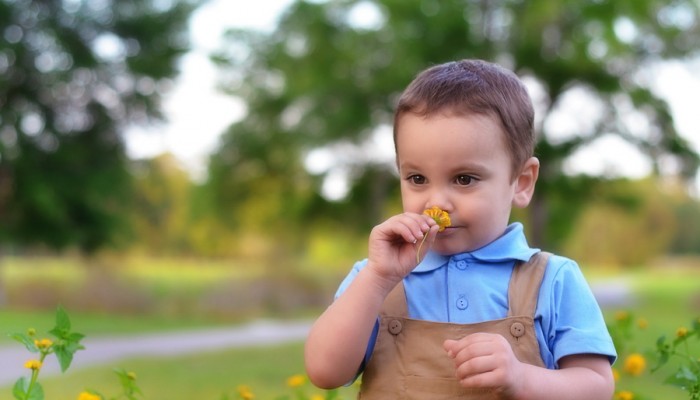
Don’t coach your child to smile!
Don’t do it before the photo-shoot, don’t do it during the photo-shoot.
A cheesy smile is not what you want. Children are very good at expressing emotion, and they will smile on their own. It’s our job as adults to be funny and help the child feel relaxed.
Capturing a pure, genuine smile is more valuable than capturing a hundred grins. If the child is having fun, he/she will smile!
Avoid clothing with strong patterns /stripes.
We don’t shoot for a children’s fashion magazine. Clothing should not compete for attention with your child. The eyes should be drawn to the child, not the clothing.
Solid colors work best, but subdued patterns would do the job just as well.
On the same note, logos should be discreet, not overpowering. Or even better, no logos at all!
Shiny, sparkly, or reflective fabric not only distracts from the subject but can also create the illusion that you’re larger than you are. The same is true for busy patterns and bold designs like stripes, polka dots, and plaid.
Boys usually look great when wearing a solid color collared shirt, such as a polo shirt.
Orange and yellow are beautiful happy colors, but…
In moderation. Orange and yellow work best as accent colors, not as the dominant color in one’s outfit.
They will compete for attention with your child’s face, and as we mentioned before, we don’t want that.
When shooting outdoors on a bright sunny day
First, have some water handy. The child will get thirsty!
Secondly, it is probably best to avoid high-contrast outfits (black shirt, white pants) and very bright colors (white and yellow).
The above creates an unnecessary technical difficulty for the photographer. Depending on the photographer, this difficulty is not particularly hard to overcome but, coupled with the fact that children don’t stand still, may result in a higher percentage of shots missed while the photographer is making yet one more adjustment on the camera.
Don’t let the children worry about getting their pictures being taken
That’s the photographer’s and parent’s job.
You don’t even need to tell the child beforehand that a photo-shoot will happen. We want the child to be ready to have fun during the shoot, not to think what “getting your pictures taken” entails.
Let’s make the eye color pop!
A little known Disney trivia fact is that there is a lot of science involved picking the right hue of pink for the pavement at Epcot.
Disney employed a team of experts who studied and analyzed the right pink color to make the grass look greener.
The science behind it is a lot of gobbly gook for most of us, but here is a Wikipedia link for you, ubergeeks:
In summary, exposing the color receptors in your eye to a particular color would make other colors look more intense.
Now, why would this matter for a photo-shoot, you may wonder?
Well, we want to make the color of your child’s eyes pop.
So, here is a little accessory color cheat-sheet. It does work better for girls, as they can always accessorize using a bow, a flower, etc.
- To make green eyes “pop,” use a slightly pink accessory.
- Blue and grey eyes: To make green eyes “pop” use an accessory that is orange, brown, or generally speaking “warm.”
- Brown eyes: To make green eyes “pop” use an accessory that is in a shade of blue or generally speaking “cold.”
Now, on the flip side, wearing a shirt/scarf/accessory with color tones similar to the color of your child’s eyes also works well in accentuating the eye color.
Tones of green for green eyes, blue/purple for blue and grey eyes, brown and muted tones of orange/peach for brown eyes.
What colors to wear?
Pastels and happy colors, in general, look great on children. Solid colors are preferable to stripes or strong patterns (see above) regardless of color.
Avoid white, especially in proximity to the face, as it tends to wash out the skin tones.
Also, avoid black, as it tends to “disappear” in photos.
Children with pink or rosy skin undertones look best in cool colors, like blue and purple. Those with golden or apricot undertones look best in warm colors, such as mocha and red.
Let the child have fun!
The shots will come on their own. Constantly reminding the kid that someone is taking pictures will not help.
If you want the child to look at the camera, the most natural thing you can do is get behind the photographer and do something you know would cause a reaction.
Do not abuse this technique as the child will start to ignore you.
Blotting paper is your friend.
This is especially true on a sunny Florida summer day. It helps control unwanted glistering on a child’s face.
Hydration is important
Not only on the day of the shoot. I am sure every parent knows this.
But I think it is worth mentioning that hydrated skin looks much better in photos. Think glowy, radiant skin.
